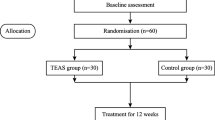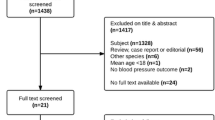Abstract
Objective
To study a non-drug therapy for hypertension disease by combining percutaneous laser and electric pulse stimulation to acupoint with music, and to test the efficiency of the combining treatment to grade 1 essential hypertension.
Methods
A total of 174 patients with grade 1 essential hypertension were randomly assigned to 3 groups with a random number table after Chinese medicine (CM) syndrome differentiation: the photoelectric and musical treatment group (Group 1, with a self-developed multi-mode audio frequency pulse photoelectric therapeutic apparatus), acupuncture group (Group 2), and oral placebo group (Group 3), 58 cases per group. The curative effect of each group was evaluated by the changes of blood pressure and CM syndrome integral before and after treatment.
Results
Compared with Group 3, there were significant decrease of blood pressure and CM syndrome integral in Group 1 and Group 2 (P<0.01). Compared with Group 2, Group 1 showed the highest decrease in systolic pressure (P<0.017). The total effective rate of anti-hypertension in Group 1 (91.38%, 53/58) was significantly higher than that in Group 2 (74.13%, 43/58) and Group 3 (18.97%, 11/58, P<0.05 or P<0.01); and that in Group 2 was also significantly higher than that in Group 3 (P<0.01). There were significant difference in the total effective rate of CM syndrome integral in both Group 1 (93.10%, 54/58) and Group 2 (84.48%, 49/58) as compared with Group 3 (17.24%, 10/58, P<0.01), while there was no significant difference between Group 1 and Group 2 (P>0.05).
Conclusions
The multi-mode audio frequency pulse photoelectric therapeutic apparatus, combining music, laser and electric pulse stimulation, is clinically useful for grade 1 essential hypertension. This "three in one" therapy method is non-invasive, easy and simple to handle. It is expected to be popularized as a new alternative treatment.
Similar content being viewed by others
References
Liu LS, ed. Hypertension. Beijing: People's Medical Publishing House; 2001:1–2.
Wolf-Maier K, Cooper RS, Banegas JR, Giampaoli S, Hense HW, Joffres M, et al. Hypertension prevalence and blood pressure levels in 6 European countries, Canada, and the United States. JAMA 2003;289:2363–2369.
Li LM, Rao KQ, Kong LZ, Yao CH, Xiang HD, Zhai FY, et al. A description on the Chinese national nutrition and health survey in 2002. Chin J Epidemiol (Chin) 2005;26:478–484.
Kearney PM, Whelton M, Reynolds K, Muntner P, Whelton PK, He J. Global burden of hypertension: analysis of worldwide data. Lancet 2005;365:217–223.
Xiong XD, ed. Internal medicine of Western medicine. Beijing: People's Medical Publishing House; 2012:143–152.
Ruan DJ, Yang ZQ. Hypertensive disease epidemiologic survey of Huairou district and risk factor analysis. Beijing Med J (Chin) 2010;32:516–518.
Lu ZY, Zhong NS, eds. Internal medicine. Beijing: People's Medical Publishing House; 2008:263–265.
Wang P. Necessity and feasibility of hypertension health promotion. Chin J Health Educat (Chin) 2004;20:334–336.
Jiang Y, Li LM. The review of prevention and control on community-based chronic disease. Chin J Prevent Control Chron Non-Communic Dis (Chin) 2000;8:49–51.
The ALLHAT Office and Coordinators for the ALLHAT Collacborative Group. Major outcomes in high-risk hypertensive patients randomized to angiotensin-converting enzyme inhibitor or calcium channel blocker vs. diuretic: the antihypertensive and lipid-lowering treatment to prevent heart attack trial (ALLHAT). JAMA 2002;288:2981–2997.
Song CX, Ouyang KH. The analysis about adverse reactions of antihypertensive drugs commonly used. Chin Foreign Med Res (Chin) 2012;27:142.
Qu YZ. Misunderstanding and processing methods on the treatment of hypertension. New Med (Chin) 2008;39:78–79,105.
Writing Group of Chinese Guidelines for the Management of Hypertension. 2010 Chinese guidelines for the management of hypertension. Chin J Cardiol (Chin) 2011;19:701–742.
Li Y, Xu LG, Deng YY, Liu H. Progress in clinical research on treatment of hypertension by acupuncture and moxibustion. J Changchun Univ Tradit Chin Med (Chin) 2006;22:71–72.
Sheng HY, Yan SX. Research progress on music therapy for treatment of hypertension patients. Chin Nursing Res (Chin) 2008;22:1701–1702.
Zhang J, Zhang YH, Bai Y. Study of music electroacupuncture. Chin Acupunct Moxibust (Chin) 2005;25:585–588.
He J, Peng YF, Mu KJ, Cheng ZH. Laser acupuncture theory and its clinical applications. Appl Laser (Chin) 2008;28:84–87.
Wang J, Xiong X. Evidence-based Chinese medicine for hypertension. Evid Based Complement Alternat Med 2013;2013:978398.
Zheng XY, ed. Guiding principle of clinical research on new drugs of Chinese medicine (trial). Beijing: China Medical Science and Technology Press; 2002:73–77.
World Health Organization in the Western Pacific Region. WHO standard acupuncture point locations in the Western Pacific Region. Beijing: People's Medical Publishing House; 2010:28, 54,75,102,146,173, 204.
Yuwen Y, Shi NN, Wang LY, Xie YM, Han XJ, Lu AP. Development of clinical practice guidelines in 11 common diseases with Chinese medicine interventions in China. Chin J Integr Med 2012;18:112–119.
Liu HN, Zhou Q, Guan L. Progress in research on hypertension by Chinese medicine. J Changchun Coll Tradit Chin Med (Chin) 2009;25:289–290.
Liu JY, Yang DH, Bai TY. The frequency analysis of clinical point in the acupuncture treatment of essential hypertension. J Shandong Univ Tradit Chin Med (Chin) 2009;3:215–216.
Wu YH, Qi ZG, You LX, Ouyang LX, Su HM, Wu BQ. Effect of needling Quchi and Taichong points on blood levels of endothelin and angiotension converting enzyme in patients with hypertension. Chin J Integr Tradit West Med (Chin) 2004;24:1080–1083.
Chen YL, Mo SL, Wu WK, Zhu YY, Luo HC, Chen JW, et al. Effect of electroacupuncture "Zusanli" on serum nitric oxide (NO) and plasma endothelin (ET) of spontaneous hypertension rats (SHR). Chin J Natur Med (Chin) 2002;4:14–16.
Schneider A, Weiland C, Enck P, Joos S, Streitberger K, Maser-Gluth C, et al. Neuroendocrinological effects of acupuncture treatment in patients with irritable bowel syndrome. Complement Ther Med 2007;15:255–263.
Hwang DS, Kim HK, Seo JC, Shin IH, Kim DH, Kim YS. Sympathomodulatory effects of Saam acupuncture on heart rate variability in night-shift-working nurses. Complement Ther Med 2011;19 (Suppl 1):S33–S40.
Li ZR, Shen MH, Peng YJ. Progress in researches on the effect of acupuncture in antagonizing oxygen stress. Chin J Integr Med 2005;11:156–160.
Jin CN, Zhang TS, Ji LX, Tian YF. Survey of studies on mechanisms of acupuncture and moxibustion in decreasing blood pressure. Chin Acupunct Moxibust (Chin) 2007;27:467–470.
Sui JH, Xiao D. Recent studies on the mechanism of acupuncture treatment of hypertension. J Clin Acupunct Moxibust (Chin) 2000;12:43–45.
Bekiroglu T, Ovayolu N, Ergun Y, Ekerbicer HC. Effect of Turkish classical music on blood pressure: a randomized controlled trial in hypertensive elderly patients. Complement Ther Med 2013;21:147–154.
Ruan JW, Wang CH, Liang Q, Lin KY, Han XL. The curative effect of music-regulated laser therapy and the quality of life of patients with primary hyper-tension. Chin J Physic Med Rehabilit (Chin) 2010;32:34–37.
Wang ZG, Shi MH, Song LM, Li XY, Tan YK, Tan RC. The effect of introvascular low intensity laser irradiation of blood on hemorheologic properties in diabetic rabbits. ACTA Laser Biol Sin (Chin) 1997;6:961–965.
Chen ZB, Song LJ, Wang ZG, Tang MR, Wu HQ. The effects of low intensity He-Ne laser irradiation and estrogen on ovariectomized rabbits' hemorheology. ACTA Laser Biol Sin (Chin) 2003;12:137–140.
Xiong GX, Song XW. Effects of semiconductor laser irradiation on erythrocyte rheology. Appl Laser (Chin) 2006;26:134–136.
Spodaryk K. The influence of low-power laser energy on red blood cell metabolism and deformability. Clin Hemorheol Microcirc 2001;25:145–151.
Yan HJ, Wan ZG. The analysis about dose and mechanism of laser irradiation on acupuncture point. ACTA Laser Biol Sin (Chin) 2006;15:550–551.
You C, Xiong X, Feng QC, Xie PC, Yi C, Chen ZB. Effects of pulse width modulation audio signals on blood pressure in hypertension model rats. Chin J Med Physics (Chin) 2008;25:527–528,533.
Gong WL, Huang SJ, Si G, Zhang KY, Chen ZB. The effects of multi-mode audio frequency pulse modulating laser together with electrical stimulation on blood pressure and hemorrheology of the spontaneously hpertensive rats. J Biomed Engineer (Chin) 2012;3:415–419.
Author information
Authors and Affiliations
Corresponding author
Additional information
Supported by the Research Project of Traditional Chinese Medicine Bureau of Guangdong Province, China (No. 20111160) and Science and Technology Plan of Guangdong Province, China (No. 2009B030801162)
Rights and permissions
About this article
Cite this article
Zhan, Hr., Hong, Zs., Chen, Ys. et al. Non-invasive treatment to grade 1 essential hypertension by percutaneous laser and electric pulse to acupoint with music: A randomized controlled trial. Chin. J. Integr. Med. 22, 696–703 (2016). https://doi.org/10.1007/s11655-016-2502-5
Received:
Published:
Issue Date:
DOI: https://doi.org/10.1007/s11655-016-2502-5




